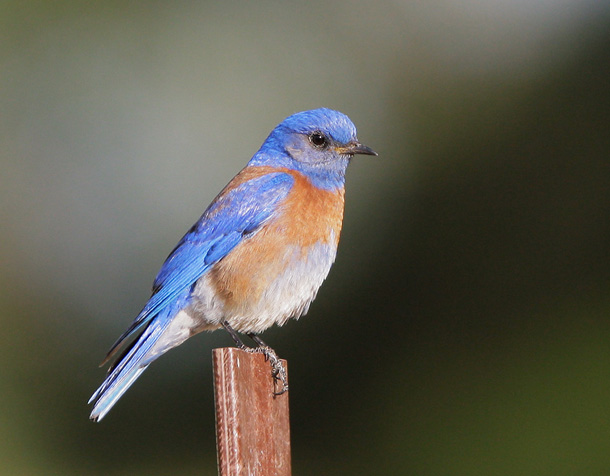BirdNote® Why Are Bluebirds Blue?
Published: February 6, 2018

A male Western Bluebird. (Photo: © Tom Grey)
(stream/download) as an MP3 file
The gorgeous blue of the Bluebird is produced by the unusual structure of the bird’s feather which reflects light.(Photo: © Tom Grey)
GELLERMAN: Bluebird, bluebird, through my window. Why are you so blue? That’s the subject of this week’s BirdNote ®. Michael Stein has more.
[Mountain Bluebird song]
STEIN: The cheery song of this Mountain Bluebird is a sure sign of spring. [Mountain Bluebird song]
Because of their glowing blue feathers, the three species of North American bluebirds – Eastern, Western, and Mountain – are among the continent’s most beautiful birds. But why are they blue? Well, a Native American myth has the dull, ugly bluebird bathing in a blue lake to acquire its colors. But the scientific explanation is no less wonderful.
[Mountain Bluebird song]
Unlike many other bird colors, blue is not a pigment. It’s a color produced by the structure of the feathers. Tiny air pockets and melanin pigment crystals in each feather scatter blue light and absorb the other wavelengths. That beautiful blue light leaves the feather to dazzle the eye of the beholder.
[Mountain Bluebird song]
And that color is not lost on a female bluebird. Male Eastern Bluebirds that are brighter blue and reflect more ultraviolet light have greater breeding success than their paler counterparts.
Children often ask why the sky is blue, and we can ask the same question about bluebirds. The answer is the same in both cases: it’s a trick of the light.
[Mountain Bluebird song]
I’m Michael Stein.
BirdNote® Why Are Bluebirds Blue? Was written by Dennis Paulson.
Back to Living on Earth
Living on Earth wants to hear from you!
Living on Earth
62 Calef Highway, Suite 212
Lee, NH 03861
Telephone: 617-287-4121
E-mail: comments@loe.org
Newsletter [Click here]
Donate to Living on Earth!
Living on Earth is an independent media program and relies entirely on contributions from listeners and institutions supporting public service. Please donate now to preserve an independent environmental voice.
NewsletterLiving on Earth offers a weekly delivery of the show's rundown to your mailbox. Sign up for our newsletter today!
 Sailors For The Sea: Be the change you want to sea.
Sailors For The Sea: Be the change you want to sea.
 The Grantham Foundation for the Protection of the Environment: Committed to protecting and improving the health of the global environment.
The Grantham Foundation for the Protection of the Environment: Committed to protecting and improving the health of the global environment.
 Contribute to Living on Earth and receive, as our gift to you, an archival print of one of Mark Seth Lender's extraordinary wildlife photographs. Follow the link to see Mark's current collection of photographs.
Contribute to Living on Earth and receive, as our gift to you, an archival print of one of Mark Seth Lender's extraordinary wildlife photographs. Follow the link to see Mark's current collection of photographs.
 Buy a signed copy of Mark Seth Lender's book Smeagull the Seagull & support Living on Earth
Buy a signed copy of Mark Seth Lender's book Smeagull the Seagull & support Living on Earth

